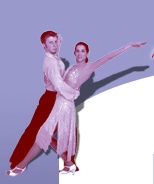
|

Free four count swing lessons & introduction!
This dance is perhaps even easier to learn than the three count hustle. This dance uses the same steps and figures as three count hustle.The Night Club Partner Dancing video produced by The Dance Store teaches four count swing. |
|||||||
Four Count Swing
Learning Area
The Moves
The only difference between four count swing and three count hustle is the footwork timing. In this dance, you simply step on each beat of the music. You can count the music and the step timing 1,2,3,4; 1,2,3,4. It’s just like marching. Now let’s talk about when to dance the four count hustle. Most dancers prefer the three count hustle over the four count swing, but when the music speeds up and gets above about 130 beats per minute, you will need to switch to the four count hustle – this gives you an extra beat of music to complete each pattern. The basic step of the four count hustle is easy, the counting called out: 1,2,3,4; 1,2,3,4. The steps are often called out: forward, back, together, forward.<< Back to top
The Music
The four count swing is perfect for fast disco music and for “techno-beat” music. The four count swing is also a perfect dance for merengue music, which is popular in Latin Clubs.Click on the link below for helpful examples of both Four Count Swing songs and CD's which feature Four Count Swing music.
Four Count Swing Music Examples >>
<< Back to top
History
Four count swing probably originated from the merengue. Both dances share many of the same patterns and both entail taking one step on each beat of the music.<< Back to top
Tips & Info
Here are some "universal tips" for learning how to dance a partner dance such as foxtrot, swing, or waltz.- First, acquire a few audio CD's of the music and play the music over and over in your home or automoble. Next, count the step timing in time to the music. This you can do sitting down, perhaps while driving. For example, for waltz, call out the 1,2,3 1,2,3 step timing in time to the music. For foxtrot, call out the step timing using slows and quicks. For cha cha and rumba, it's important to recognize the first beat of each measure. Otherwise you may dance on the incorrect beat. If necessary, have your instructor assist you in learning to count the step in time to the music. Dancing in correct time to the music is absolutely essential. Continue this "sitting down and listening" exercise for as long as necessary until you can easily and automatically count the step in time to the music. The Ultimate Ballroom Practice CD sold by The Dance Store might be a helpful
tool.
- Next, practice the basic step, including the step timing, until the step is automatic - like tying a shoe. Using east coast swing as an example, practice the triple step, triple step, rock step basic until it's automatic. Next, practice this basic to music until it becomes automatic. Many basic steps can be practiced without a partner.
At this point, your brain is "freed up" to allow learning steps and patterns because you no longer have to concentrate on timing and step counting.
Many folks get frustrated if they can't dance competently immediately. Certainly individuals vary in dance aptitude, but all dancers must go through the awkward stages before they get to the polished stage.
<< Back to top




